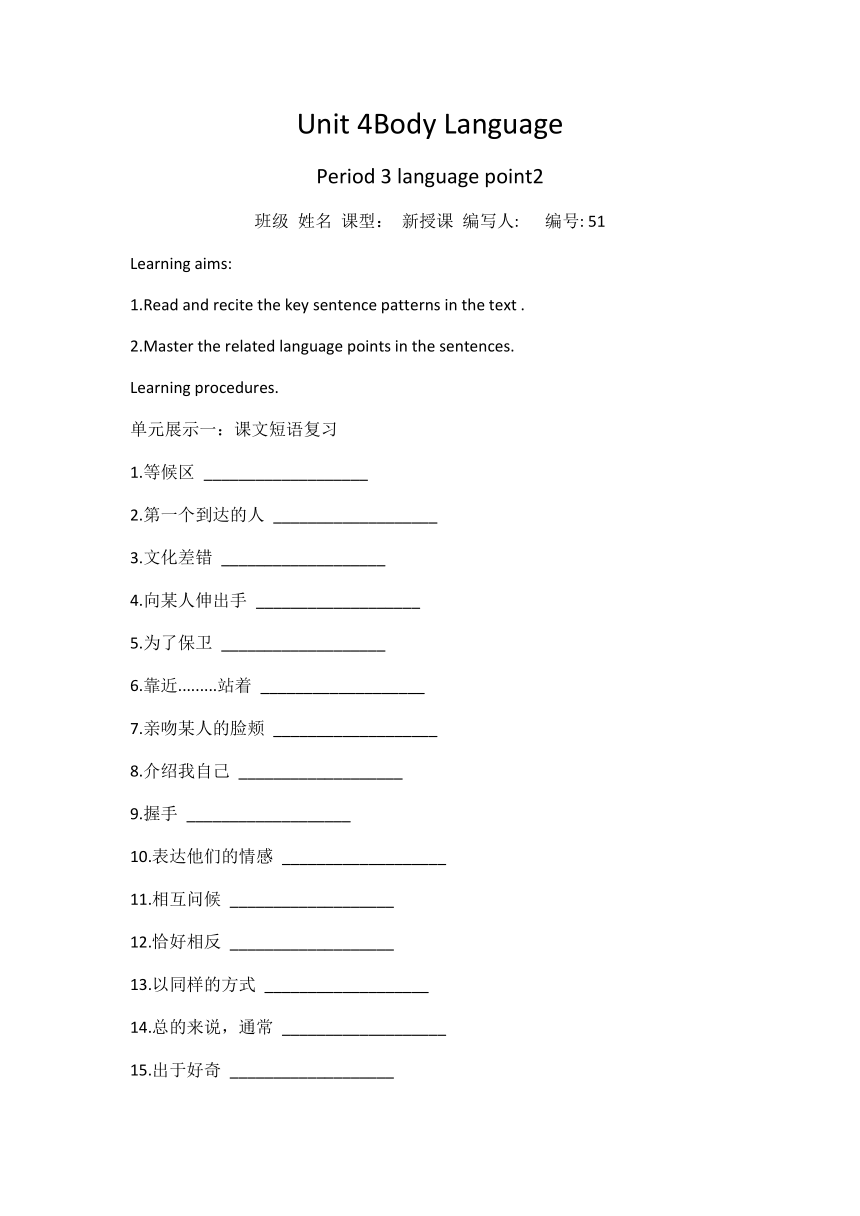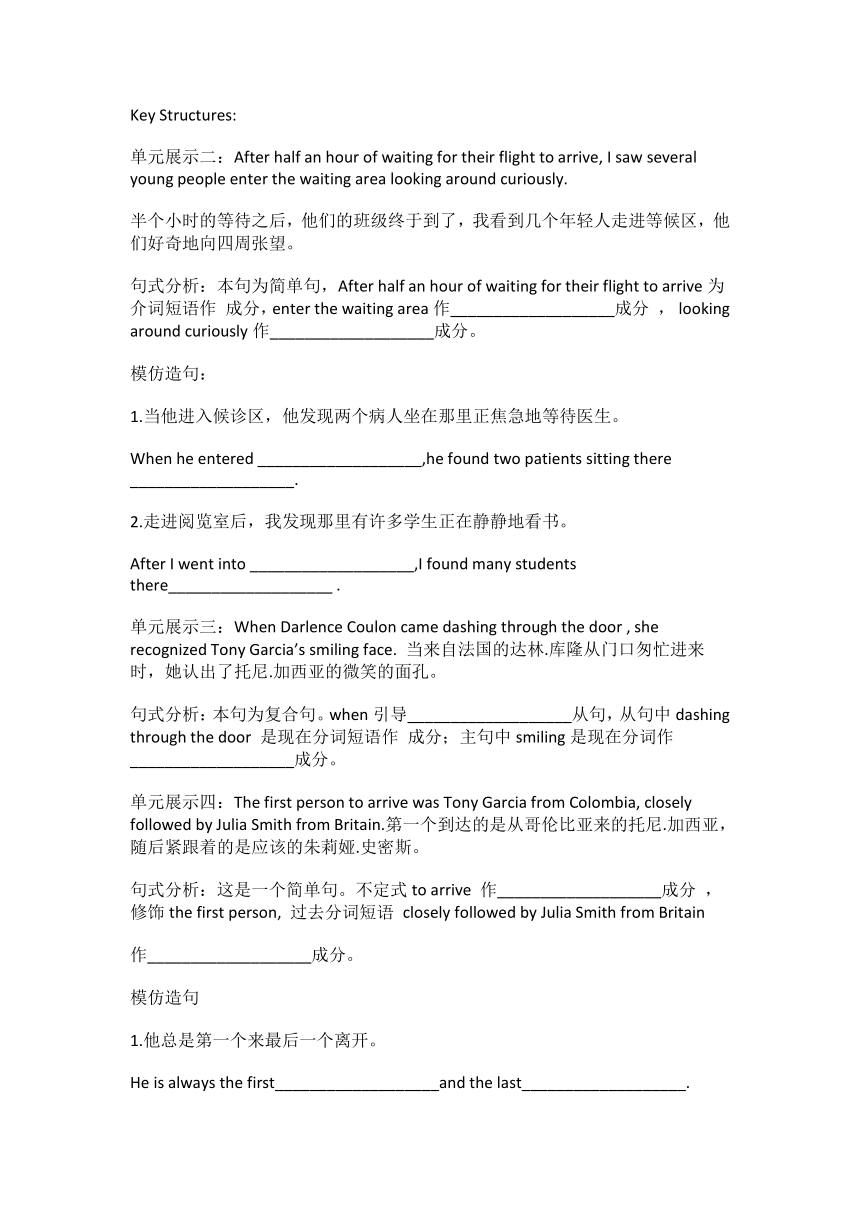人教版必修四:Unit 4 Body Language language point2 学案(无答案)
文档属性
| 名称 | 人教版必修四:Unit 4 Body Language language point2 学案(无答案) |  | |
| 格式 | docx | ||
| 文件大小 | 20.4KB | ||
| 资源类型 | 教案 | ||
| 版本资源 | 人教版(新课程标准) | ||
| 科目 | 英语 | ||
| 更新时间 | 2022-03-10 13:02:33 | ||
图片预览


文档简介
Unit 4Body Language
Period 3 language point2
班级 姓名 课型: 新授课 编写人: 编号: 51
Learning aims:
1.Read and recite the key sentence patterns in the text .
2.Master the related language points in the sentences.
Learning procedures.
单元展示一:课文短语复习
1.等候区 ___________________
2.第一个到达的人 ___________________
3.文化差错 ___________________
4.向某人伸出手 ___________________
5.为了保卫 ___________________
6.靠近.........站着 ___________________
7.亲吻某人的脸颊 ___________________
8.介绍我自己 ___________________
9.握手 ___________________
10.表达他们的情感 ___________________
11.相互问候 ___________________
12.恰好相反 ___________________
13.以同样的方式 ___________________
14.总的来说,通常 ___________________
15.出于好奇 ___________________
Key Structures:
单元展示二:After half an hour of waiting for their flight to arrive, I saw several young people enter the waiting area looking around curiously.
半个小时的等待之后,他们的班级终于到了,我看到几个年轻人走进等候区,他们好奇地向四周张望。
句式分析:本句为简单句,After half an hour of waiting for their flight to arrive为介词短语作 成分,enter the waiting area作___________________成分 , looking around curiously作___________________成分。
模仿造句:
1.当他进入候诊区,他发现两个病人坐在那里正焦急地等待医生。
When he entered ___________________,he found two patients sitting there ___________________.
2.走进阅览室后,我发现那里有许多学生正在静静地看书。
After I went into ___________________,I found many students there___________________ .
单元展示三:When Darlence Coulon came dashing through the door , she recognized Tony Garcia’s smiling face. 当来自法国的达林.库隆从门口匆忙进来时,她认出了托尼.加西亚的微笑的面孔。
句式分析:本句为复合句。when引导___________________从句,从句中dashing through the door 是现在分词短语作 成分;主句中smiling是现在分词作___________________成分。
单元展示四:The first person to arrive was Tony Garcia from Colombia, closely followed by Julia Smith from Britain.第一个到达的是从哥伦比亚来的托尼.加西亚,随后紧跟着的是应该的朱莉娅.史密斯。
句式分析:这是一个简单句。不定式to arrive 作___________________成分 ,修饰the first person, 过去分词短语 closely followed by Julia Smith from Britain
作___________________成分。
模仿造句
1.他总是第一个来最后一个离开。
He is always the first___________________and the last___________________.
2.她是第一个获奥运会金牌的女子。
She was the first woman___________________ the gold model in the Olympic Games.
单元展示五:Not all cultures greet each other the same way ,nor are they comfortable in the same way with touching or distance between people. 各种文化背景下的相互问候的方式不尽相同,身体接触和相互间距离的程度也不一样。
句式分析:(1)not all 表示部分否定,意思为___________________。英语中含有“整体,全部”的词 ___________________等词与否定词连用时表示部分否定。
汉译英:Not everyone likes watching the program,Amazing Chinese.
英译汉:并非人人都愿意去北京。___________________
Everybody ___________________go to Beijing.
= ___________________would like to go to Beijing.
(2)nor are they......是倒装句,为部分倒装,表示“........也不 ”的意思。常用“neither/nor +系动词/情态动词/助动词+主语 ”结构。
我昨天没去游泳,杰克也没去。
I didn’t go swimming yesterday,___________________ .
如果你不去看电影,我也不去。
If you don’t go to see the movies, ___________________.
“日清过关”达标训练
1.There is a ___________________(swim)pool in our school.
2.___________________ (look)out through the window ,we saw a beautiful scenery.
3.We are___________________ (curiosity) to know how the air crash happened.
4.Her ___________________(face) expressions tell you how she feels.
5.They are___________________ (like) to live near the harbor, but I ’m not sure.
6.When___________________ (introduce )to each other , we reached out our hands.
7.“What’s it ” asked the boy___________________ (curious)with his eyes wide open.
Period 3 language point2
班级 姓名 课型: 新授课 编写人: 编号: 51
Learning aims:
1.Read and recite the key sentence patterns in the text .
2.Master the related language points in the sentences.
Learning procedures.
单元展示一:课文短语复习
1.等候区 ___________________
2.第一个到达的人 ___________________
3.文化差错 ___________________
4.向某人伸出手 ___________________
5.为了保卫 ___________________
6.靠近.........站着 ___________________
7.亲吻某人的脸颊 ___________________
8.介绍我自己 ___________________
9.握手 ___________________
10.表达他们的情感 ___________________
11.相互问候 ___________________
12.恰好相反 ___________________
13.以同样的方式 ___________________
14.总的来说,通常 ___________________
15.出于好奇 ___________________
Key Structures:
单元展示二:After half an hour of waiting for their flight to arrive, I saw several young people enter the waiting area looking around curiously.
半个小时的等待之后,他们的班级终于到了,我看到几个年轻人走进等候区,他们好奇地向四周张望。
句式分析:本句为简单句,After half an hour of waiting for their flight to arrive为介词短语作 成分,enter the waiting area作___________________成分 , looking around curiously作___________________成分。
模仿造句:
1.当他进入候诊区,他发现两个病人坐在那里正焦急地等待医生。
When he entered ___________________,he found two patients sitting there ___________________.
2.走进阅览室后,我发现那里有许多学生正在静静地看书。
After I went into ___________________,I found many students there___________________ .
单元展示三:When Darlence Coulon came dashing through the door , she recognized Tony Garcia’s smiling face. 当来自法国的达林.库隆从门口匆忙进来时,她认出了托尼.加西亚的微笑的面孔。
句式分析:本句为复合句。when引导___________________从句,从句中dashing through the door 是现在分词短语作 成分;主句中smiling是现在分词作___________________成分。
单元展示四:The first person to arrive was Tony Garcia from Colombia, closely followed by Julia Smith from Britain.第一个到达的是从哥伦比亚来的托尼.加西亚,随后紧跟着的是应该的朱莉娅.史密斯。
句式分析:这是一个简单句。不定式to arrive 作___________________成分 ,修饰the first person, 过去分词短语 closely followed by Julia Smith from Britain
作___________________成分。
模仿造句
1.他总是第一个来最后一个离开。
He is always the first___________________and the last___________________.
2.她是第一个获奥运会金牌的女子。
She was the first woman___________________ the gold model in the Olympic Games.
单元展示五:Not all cultures greet each other the same way ,nor are they comfortable in the same way with touching or distance between people. 各种文化背景下的相互问候的方式不尽相同,身体接触和相互间距离的程度也不一样。
句式分析:(1)not all 表示部分否定,意思为___________________。英语中含有“整体,全部”的词 ___________________等词与否定词连用时表示部分否定。
汉译英:Not everyone likes watching the program,Amazing Chinese.
英译汉:并非人人都愿意去北京。___________________
Everybody ___________________go to Beijing.
= ___________________would like to go to Beijing.
(2)nor are they......是倒装句,为部分倒装,表示“........也不 ”的意思。常用“neither/nor +系动词/情态动词/助动词+主语 ”结构。
我昨天没去游泳,杰克也没去。
I didn’t go swimming yesterday,___________________ .
如果你不去看电影,我也不去。
If you don’t go to see the movies, ___________________.
“日清过关”达标训练
1.There is a ___________________(swim)pool in our school.
2.___________________ (look)out through the window ,we saw a beautiful scenery.
3.We are___________________ (curiosity) to know how the air crash happened.
4.Her ___________________(face) expressions tell you how she feels.
5.They are___________________ (like) to live near the harbor, but I ’m not sure.
6.When___________________ (introduce )to each other , we reached out our hands.
7.“What’s it ” asked the boy___________________ (curious)with his eyes wide open.
同课章节目录
